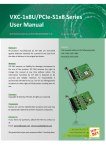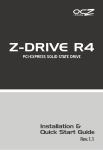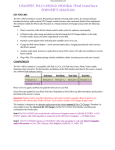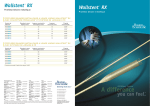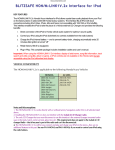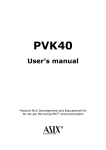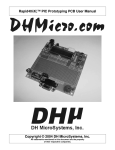Download User Manual
Transcript
LabMaster Series TECHNOLOGIES Unistep LabMaster Series SPI SERIAL PORT INTERFACE MODULE USER MANUAL Copyright © 2006 - Unistep Technologies SPI - Serial Port Interface 2 User Manual SPI ~~~~~~ SSEERRIIAALL PPOORRTT IINNTTEERRFFAACCEE ~~~~~~ USER MANUAL Section 1 - Introduction Features .......................................................................................................... Package Contents ............................................................................................ Installation ...................................................................................................... Section 2 - Circuit Description Circuit Diagram ................................................................................................ Parts List and the Component Placement Diagram ............................................. I/O Pin Assignments ........................................................................................ Power Input .................................................................................................... Processor ........................................................................................................ Serial Port ....................................................................................................... Configuration ................................................................................................... Indicators ........................................................................................................ Analog Input Port ............................................................................................ Digital Input Port ............................................................................................. Digital Output Port ........................................................................................... Section 3 - Command Interpreter Command Structure ......................................................................................... Command Set .................................................................................................. Section 4 - Control Panel Installation ...................................................................................................... Serial Port Settings .......................................................................................... SPI Exec ......................................................................................................... Digital Output Port ........................................................................................... Digital Input Port ............................................................................................. Analog Input Port ............................................................................................ PWM Output .................................................................................................... Stepper Output ................................................................................................ Frame Display Boxes ........................................................................................ Section 5 - Support Internet www .................................................................................................. Contacts .......................................................................................................... Section 6 - Appendices Command Reference ........................................................................................ Circuit Diagram ............................................................................................... Parts List & Component Placement Diagram ...................................................... Copyright © 2006 Unistep Technologies 3 3 3 4 4 4 4 4 5 5 6 6 6 6 7 7 8 8 9 9 9 9 10 10 11 12 12 13 15 16 SPI-LM-USR-004 User Manual SPI - Serial Port Interface 3 1. INTRODUCTION Thank you for purchasing the LabMaster SPI Module. This is a very capable circuit with powerful hardware and firmware features. We hope that you will find the SPI module very helpful for your serial port interfacing, automatic control, and digital experimentation needs. 1.1 Features • • • • • • • • • • • • • • • • • • • • • • • 8+1 Channel digital output port (8 bit latched data + 1 clock) 8+1 Channel digital input port (8 bit buffered data + 1 clock) 5+1 Channel Analog input port 2 Stepper motor control outputs 2 PWM and DC motor control outputs LED indicators for digital outputs 16-Pin dual-row headers for all I/O channels 9-Pin D-Sub RS-232 Interface for communicating with the host PC Serial communication configuration switches MPU configuration and reset switches Auto-transmit mode for initial system checking Ready/Activity LED indicator DIP-switch selectable 1200, 9600, 19200, and 57600 Baud transmission speeds Parity enable/disable and parity type selection LED lamps indicators for Parity and Framing errors Transparent mode of operation for simple I/O needs Powerful SPI Exec Command Interpreter for sophisticated control functions LED lamp indicator for MPU command mode Support for external voltage reference input Fully configurable PWM output channel Reverse polarity input power protection Fully socketed IC's Vcc and Gnd power lines included in I/O headers for powering external circuits 1.2 Package Contents Please make sure that you have the following items in the SPI package: 1. The SPI Module (1) 2. Flat ribbon cable segments with 16-Pin IDC connector at one end (3) 3. Software and Documentation CD (1) 1.3 Installation No assembly is required, as the SPI module is shipped fully assembled and tested. Copyright © 2006 Unistep Technologies SPI-LM-USR-004 SPI - Serial Port Interface 4 User Manual 2. CIRCUIT DESCRIPTION 2.1 Circuit Diagram Full circuit diagram is included at the end of this manual. You may find it useful to keep it open while reading the following sections about the circuit details. 2.2 Parts List and the Component Placement Diagram At the end of this manual you will also find one page with the Parts List and Component Placement Diagram. These will be useful if you need to locate a component on the SPI board, or if you need to find replacement parts. 2.3 I/O Pin Assignments All I/O lines of the SPI circuit are brought out on 16-Pin dual-row header strips. These pins are numbered as shown in the figures below. Pin #1 can be identified in two ways: 1) Pin numbers 1,2,15,and 16 are printed on the board. 2) On the solder side, pin number 1 has a square solder pad, instead of the usual oval pad. It is recommended that you connect the ribbon cables so that the colored marker conductor indicates circuit #1. J5 J3 Vcc Vcc Gnd Gnd 1 2 3 4 5 6 7 8 9 10 11 12 13 14 15 16 AN 0 AN 1 AN 2 AN 3 AN 4 AN 5 / Vref PW M PW M DIR Port A Analog Input Vcc Vcc Gnd Gnd CLKI J4 1 2 3 4 5 6 7 8 9 10 11 12 13 14 15 16 DIG DIG DIG DIG DIG DIG DIG DIG IN IN IN IN IN IN IN IN Port B Digital Input 0 1 2 3 4 5 6 7 Vcc Vcc Gnd Gnd CLKO STEP STEP DIR 1 2 3 4 5 6 7 8 9 10 11 12 13 14 15 16 DIG DIG DIG DIG DIG DIG DIG DIG OUT OUT OUT OUT OUT OUT OUT OUT 0 1 2 3 4 5 6 7 Port C Digital Output 2.4 Power Input This is the circuit built around the Q1 Power MOSFET. It does three functions: a) Reverse power polarity protection with Q1 and R1, b) “Power Good” indication with R2 and D12, and c) Power supply filtering and decoupling with C1, C2, and C10-C13. 2.5 Processor U1 is a PIC16F74 MPU that manages the serial port, all host communications, and all I/O lines on board the SPI. It runs the SPI Exec control program that interprets and executes the commands received from the controller application running on the host computer. U1 runs at a clock frequency of 12 MHz, as determined by the X1 oscillator crystal. MPU reads the DIP switches S1-1 thru S1-6 for configuration information and provides status indicators with LED lamps D8-D11. There are two indicators that display information about the processor: MPU Mode (D11): Works in conjunction with S1-6 switch to indicate that the MPU is in the Command Interpreter Mode. SPI Ready (D10): Steady ON - SPI is ready to accept commands Blinking - A reset operation underway or commands are being executed 2.6 Serial Comm Port Copyright © 2006 Unistep Technologies SPI-LM-USR-004 SPI - Serial Port Interface 5 User Manual All communication with the host PC takes place via the serial Port. J2 connector is a 9-Pin female socket that is wired as a DCE (Data Communication Equipment) interface so that a single 9-conductor M/F serial cable can be used without requiring gender changers or null modem adapters. J2 provides null modem functionality by shorting RTS line with CTS and DSR line with DTR. Data Set Ready - DSR Request To Send -RTS Clear To Send - CTS Ring Indicator - RI Figure 3 DCE wired DB-09 socket connector pin assignments 2.7 1 << >> << << CD - Carrier Detect RxD - Receive Data TxD - Transmit Data DTR - Data Terminal Ready SG- Signal Ground >> >> << << -- 6 2 7 3 8 4 9 5 Configuration DIP Switch Bank S1 is used to set the SPI communication parameters as follows (C – Closed (ON), O – Open (OFF)): 1 2 3 4 5 6 1 2 3 4 5 6 1 2 3 4 5 6 1 2 3 4 5 6 1 2 3 4 5 6 1 2 3 4 5 6 1 2 3 4 5 6 1 2 3 4 5 6 O - Odd Parity 1 2 3 4 5 6 C C - 1200 Baud 1 2 3 4 5 6 1 2 3 4 5 6 1 2 3 4 5 6 1 2 3 4 5 6 C - Transparent Mode O - Interpreter Mode C - Normal Transmission O - Auto Transmission C - Parity Disable O - Parity Enable C - Even Parity O C - 9600 Baud C O - 19200 Baud O O - 57600 Baud Copyright © 2006 Unistep Technologies SPI-LM-USR-004 SPI - Serial Port Interface 6 User Manual Interpreter Mode This is the "Normal" mode of operation. SPI Exec program receives commands from the host application through the serial port and executes the commands. Transparent Mode In this mode SPI Exec treats all transmissions from the host application as binary data and writes them to the Digital Output Port. Each write operation is followed by a "negative" pulse on the ClkO line. In this mode SPI Exec also continuously monitors the ClkI line for any transitions. When a transition is detected, it reads the signals at the Digital Input Port and sends the data as a single byte to the host application. Normal Transmission A transmission from the SPI Module to the host application takes place only as a response to a command received from the host application. The configuration switches control the serial transmission parameters. Auto Count In this transmission mode, SPI Exec configures the SPI Module for communication at 1200 BAUD, 8 Bits, No parity, and one stop bit (1200, N, 8, 1), and continuously transmits single byte characters that count up from 00h to FFh. The purpose of this mode is to provide a continuous stream of characters so that a terminal program can be used to confirm successful serial transmission between the host PC and the SPI Module. Note: SPI Module needs to be reset to recognize any configuration changes, since these switches are only read during the initial power-up or when a Reset operation is initiated. 2.8 2.9 Indicators Power, D12 On - Indicates that power is on and the polarity is right MPU Mode, D11 Off - MPU is in the Command Interpreter mode. It will receive commands from the host application, carry out the commands, and send a response back with a return code. On - MPU is in the Transparent Mode. Any character received by the SPI module will be written to the Digital Output Port, followed by a clock pulse on the CLKO line. Also, the data at the Digital Input port will be read upon detection of a READ pulse on the CLKI line, and will be sent to the host application as a single byte. Ready, D10 On - SPI has been initialized and the MPU is ready. Off - MPU is not running. Pressing the RESET button should start the MPU. Blink - Command has been received and processed by the MPU Parity Error, D9 On - Incorrect parity bit detected Frame Error, D8 On - Invalid async frame received. (Usually indicates mismatch in BAUD rates). Analog Input Port (Port A) AN0 - AN4 Analog Input Channels AN5/Vref This input is the Analog Input Channel #5, AN5, at its default setting. It can also function as the external reference input, Vref, that will be used for A-to-D conversions. The function of this input can be selected with SPI Exec commands. MPU normally uses the Vcc supply voltage as its internal reference for the A-to-D converter. If more stability, accuracy, or a different input range is desired, this pin can be selected as the input for an external voltage reference source. When external reference is selected, MPU will use the voltage at this pin as the reference for all A-to-D conversion functions on all analog inputs. PWM Pulse-Width Modulator output Copyright © 2006 Unistep Technologies SPI-LM-USR-004 SPI - Serial Port Interface 7 User Manual PDIR Pulse-Width Modulator Direction output when PWM signal is used for DC motor speed control. If required, this output can be used as a general-purpose digital output line. 2.10 Digital Input Port (Port B) DI0 - DI7 Digital input lines for TTL compatible digital logic signals. An octal buffer circuit is used to buffer and isolate the input lines from the bi-directional MPU bus. CLKI Clock line for clocked read operations. Can be read with a command and can also be used as a general-purpose digital input line. 2.11 Digital Output Port (Port C) DO0 - DO7 Buffered Digital output lines. A bank of 8 LED lamps are used to show the status of each line. Lamp is ON when the corresponding digital output line is HIGH. CLKO Clock output line. Can be set, reset, and pulsed with commands. Not buffered. SDIR Direction control bit for the stepper motor control applications. Can be used as a generalpurpose digital output line with stepper output commands. Not buffered. STEP Step pulse for stepper motor control applications. Duration of the pulse and the pulse repetition period can be preset, and the pulse generation can be started and stopped with stepper commands. Not buffered. Copyright © 2006 Unistep Technologies SPI-LM-USR-004 SPI - Serial Port Interface 8 User Manual 3. COMMAND INTERPRETER SPI MPU manages communications, controls all hardware resources on board, and also runs the SPI Exec command interpreter when the MPU MODE switch S1-6 is in closed position and the MPU Mode indicator is OFF. In this mode MPU always watches the serial port and immediately executes any commands received from the host. Except for the System Reset command, it also sends an acknowledgement response back to the host as soon as the command is executed. If errors were detected, an Error Response may be sent back. 3.1 Command Structure Commands and responses are carried by Command frames and have identical structures. Command frames are made up of four sections as shown below: hh op nn…mm tt Trailer Byte, Hex "EF" Data Bytes, as many as required by the Op Code Command Op-Code Header Byte, Hex "FE" For example, the following hex representation of a command will set the stepper pulse duration to 100 ms: FE 54 64 EF 3.2 Command Set The complete list all SPI Exec commands and responses can be found at the end of this manual. Please note that even though the list shows commands and responses as two-digit hex numbers, actual commands and any data carried within the frames are simply 8-bit binary numbers. The Mnemonic representations of the op-codes are only used for documentation purposes and can be handy for use as programming constants (literals). Copyright © 2006 Unistep Technologies SPI-LM-USR-004 SPI - Serial Port Interface 9 User Manual 4. SPI CONTROL PANEL SPI Control Panel application is designed to facilitate functional testing of the SPI module, as well as to provide an easy-to-use interface that can be used as the "front end" for simple experiments and demo setups. 4.1 Installation The computer disk included with the SPI package has three directories at the root level 1. 2. 3. Control Panel User manual Data Sheets The 'Control Panel' directory contains one .exe file and at least one .ocx file. The .exe file is the Control Panel program and can be copied to any directory of your choice. The .ocx file, however, needs to be copied to the windows system directory. For most PC installations and MS Windows versions, one common system directory is 'c:\windows\system'. If the .ocx file is copied into this directory, the main Control Panel program can be run from any location. 4.2 Serial Port Settings Serial Port setup and configuration controls of the SPI Control Panel program are grouped on the right-hand side section. Remember that you need to push (=click on) the Apply button to activate any changes made to the serial port settings. (Of course, SPI settings also need to be matched to the control panel settings for any successful communication to take place!) Copyright © 2006 Unistep Technologies SPI-LM-USR-004 User Manual SPI - Serial Port Interface 10 Comm Port You can use any of the Comm Ports 1 - 4 to communicate with the SPI module, depending on which com port hardware is present on your computer. Speed You can select 1200, 9600, 19200, or 57600 BAUD. Parity Parity bit can be disabled or odd/even parity can be selected. Comm Errors Any communication errors in the transmissions received from the SPI module will be indicated by these error indicators. They can be cleared using the Clr button. 4.3 SPI Exec When the SPI Control Program is run, it immediately carries out the following actions: • • • • • • Initialize the PC serial port and open the communication channel Initialize various internal parameters Contact the SPI module and get the SPI Exec version number Initialize the SPI module with the internal parameters Clear SPI digital output port bits and stop any PWM or Stepper activity Turn the red "Power" light next to the Reset button from red to green to indicate that all is well. Once the "Power" indicator turns green, the SPI Control Panel is ready to communicate with the SPI Exec. 4.4 Digital Output Port The status of the 8 buffered digital output lines can be viewed and changed with the Digital Output Port indicators. The dull red color indicates a logic LOW output. A bright red color indicates a logic HIGH output on that line. The SPI Control Panel Digital Output Port data bit indicators and the ClkO line indicator can be clicled on with the mouse to turn the corresponding bit (and the associated LED lamp) on and off. The "All ON" and "All OFF" buttons can turn all bits on and off, respectively, all at the same time. 4.5 Digital Input Port The SPI Control Panel digital input port section has indicators to show the status of the 8 buffered digital input lines. A dull red color indicates a logic LOW and the bright red color indicates a logic HIGH. Digital Input Port indicators are "display only" indicators, naturally, and can not be "clicked on". The upper Read button reads and displays all Digital Input Port data bits. The lower Read button is used only to read the input clock line, ClkI. 4.6 Analog Input Port This section of the SPI Control Panel manages the analog input port configuration, and displays the values of the analog input signals. • • • • • The reference voltage source selection defaults to "Int (Internal)". This means that the SPI module will use the 5 V DC supply line (Vcc) as its voltage reference. If an external reference is used, the "Ext" button should be selected, and the exact voltage of the reference should be entered into the Vref text box. When "Ext" is selected as the reference source, Channel 5 (AN5) is no longer available as an analog input channel, and its corresponding "Count" and "Volts" text boxes show "---" The first column, "Count", of 6 text boxes show the 8-bit digital values read from each of the 6 Analog Input Lines. The "Volts" column shows the voltage reading that corresponds to the count value when the reference voltage has the value indicated in the Vref text box. Analog inputs are polled once each time the "Read" button is pressed. Copyright © 2006 Unistep Technologies SPI-LM-USR-004 SPI - Serial Port Interface 11 User Manual 4.7 PWM Output The PWM section of the SPI Control Panel is used to configure and control the PWM signals generated by the SPI Module. The period, duration of the "on" or "high" portion of the waveform, and a "Direction" signal can be precisely controlled to obtain the desired PWM operation. Pulse Duration This parameter is shown in the text box named "Pulse". The value cannot be entered directly, but it can be incremented and decremented in steps of 1 and 10 using the buttons with the arrows. Each count represents a duration of 1.3 µs, and can be between 0 and 255. Pulse Period The text box named "Period" shows the pulse period of the PWM signal. Each count represents 5.3 µs, and can be incremented and decremented in steps of 1 and 10 using the buttons with the blue arrows. The valid values are between 1 and 255. Direction Even though a PWM signal has no "direction" associated with it, since a major class of applications for PWM involves DC motor control, the SPI module provides a direction signal for a DC motor that might be driven with the PWM output. Selecting the "H" or "L" controls the level of the PDIR signal, and can be utilized to provide direction control for the DC motor. For any application that does not require a direction output, this signal can be utilized as a generalpurpose digital output. Start, Stop Once the pulse configuration parameters are set, the PWM signal can be started and stopped with these buttons. The stop/start operations do not affect the configuration settings. Program will retain the configuration information until it is terminated. Note: Even though the SPI Control Panel lets you individually and independently adjust the pulse duration and pulse period (therefore the frequency), it will not prevent you from entering invalid combinations. One such example is to enter a pulse duration that is longer than the period of the signal. The behaviour of the SPI Module for such invalid data can be unpredictable. Responsibility for ensuring the validity of the configuration data rests with the user. 4.8 Stepper Output The Stepper Motor section of the SPI Control Panel is used to configure and control the Stepper Motor Control signals generated by the SPI Module, much like the PWM section. Duration of the step pulse, its repetition rate, and the direction signal can all be individually controlled. Pulse Duration This parameter is shown in the text box named "Pulse". The value cannot be entered directly, but it can be incremented and decremented in steps of 1 and 10 using the buttons with the arrows. Each count represents a duration of 1.0 ms, and can be between 0 and 255. Pulse Period The text box named "Period" shows the pulse period of the stepper signal. Each count represents 1.0 ms, and can be incremented and decremented in steps of 1 and 10 using the buttons with the blue arrows. The valid values are between 1 and 255. Direction The SDIR signal level can be controlled with the direction buttons. Selecting the "H" or "L" buttons sets the SDIR signal to the "High" and "Low" levels, respectively. If this signal is not being used to control the direction of a stepper motor, it can serve perfectly as a generalpurpose digital output. Start, Stop Once the pulse configuration parameters are set, the stepper signal can be started and stopped with these buttons. The stop/start operations do not affect the configuration settings. Program will retain the configuration information until it is terminated. Note: Even though the SPI Control Panel lets you individually and independently adjust the pulse duration and pulse period (therefore the repetition rate), it will not prevent you from entering invalid combinations. One such example is to enter a pulse duration that is longer than the period of the signal. The behaviour of the SPI Copyright © 2006 Unistep Technologies SPI-LM-USR-004 SPI - Serial Port Interface 12 User Manual Module for such invalid data can be unpredictable. Responsibility for ensuring the validity of the configuration data rests with the user. 4.9 Frame Display Boxes The "Tx" and "Rx" text boxes are provided as a visual confirmation of the command frames exchanged between the SPI Control Panel and the SPI Module. These also work well to illustrate the use of the command frames for various control actions. Tx Box The "Tx" text box at the bottom of the SPI Control Panel screen show the control frames transmitted to the SPI Module when on-screen controls are used to control the SPI Module. Rx Box The "Rx" text box at the bottom of the SPI Control Panel screen show the command frames received from the SPI Module. Copyright © 2006 Unistep Technologies SPI-LM-USR-004 SPI - Serial Port Interface 13 User Manual 5. SUPPORT We are here to help if you need assistance in using or troubleshooting the SPI Module or the SPI Control Panel. Please do not hesitate to contact Unistep Tech Support using any of the means listed below: Internet Our web site www.unistep.ca has some support information and we are adding new material all the time. E-Mail Please use our e-mail support address [email protected] for any questions, comments, or recommendations you may wish to send our way. We strive to reply within two days. Phone Please contact us at 416-619-9308 if you need immediate help. Copyright © 2006 Unistep Technologies SPI-LM-USR-004 SPI - Serial Port Interface 14 User Manual SPI Exec Command Summary v1.0 Function Group Cmnd Resp Op-Code Byte Data Byte 1 Data Byte 2 Mnemonic C R C R 01 01 02 02 ---nn ---mm RST -SID -- C R C 10 10 11 nn -nn --mm R C R C R C R C R 11 12 12 13 13 14 14 15 15 -nn -------- C R C R 20 20 21 21 C R C R C R C R C R C R C R C R C R Command / Operation Length System & Config System Reset System Reset Proceeding Report SPI Exec ID SPI Exec version follows, <nn.mm> 1 1 1 3 Write Output Byte <nn> Byte written to Output Port Write Output Word <mm nn> 2 1 3 ---------- OUB nn -OUW nn,mm -SCD -CLP -CLH -CLL -- Word written to Output Port Set Output Clock Duration to <nn> ms Output clock duration set Pulse Output Clock Output clock pulsed Set Output Clock to HIGH Output clock set to HIGH Clear Output Clock to LOW Output Clock set to LOW 1 2 1 1 1 1 1 1 1 -nn -nn ----- INP -INC -- Read Digital Input Port Read <nn> from Input Port Read Input Clock Line Read <nn> on input clock line 1 2 1 2 30 30 31 31 32 32 nn nn ----- -mm ----- RAC nn -INV -EXV -- Read Analog Channel <nn> Count <mm> read from Channel <nn> Select Internal Vref ADC configured for internal Vref Select External Vref ADC configured for External Vref 2 3 1 1 1 1 40 40 41 41 42 42 43 43 44 44 45 45 --------nn -nn -- ------------- PWO -PWF -PDH -PDL -PWD nn -PWP nn -- Start PWM Output PWM output Started Stop PWM Output PWM output stopped Set PWM Direction Line to HIGH PWM Direction line set to HIGH Set PWM Direction Line to LOW PWM Direction Line cleared to LOW Set PWM signal ON Duration to <nn> PWM signal ON duration set Set PWM Period to <nn> PWM Period set 1 1 1 1 1 1 1 1 2 1 2 1 Digital Output Digital Input Analog Input PWM Output Copyright © 2006 Unistep Technologies SPI-LM-USR-004 SPI - Serial Port Interface 15 User Manual STEPPER Output C R C R C R C R C R C R 50 50 51 51 52 52 53 53 54 54 55 55 --------nn -nn -- ------------- STO -STF -SDH -SDL -STD -STP -- Start Stepper Output Stepper started Stop Stepper Output Stepper stopped Set Stepper Direction to HIGH Stepper direction set to HIGH Set Stepper Direction to LOW Stepper direction set to LOW Set Stepper Pulse Duration to <nn> ms Stepper pulse duration set Set Stepper Pulse Period to <nn> ms Stepper pulse period set 1 1 1 1 1 1 1 1 2 1 2 1 C R C R C R C R 60 60 61 61 62 62 63 63 nn ------nn --------- DIC -TIC -RIC -UIC -- NOT IMPLEMENTED IN VERSION 1.0 Download I2C Packet of <nn> bytes I2C packet downloaded Transmit I2C Packet from Buffer I2C Packet Transmitted Receive I2C Packet I2C Packet Received Upload I2C Packet Uploading I2C packet of <nn> bytes nn+2 1 1 1 1 1 1 nn+2 R R R R R F0 F1 F2 F3 F4 ------ ------ CNR CFE CRE ETO OVR Command not Recognized Command Framing Error Parameter Range Error Event Time Out Command Buffer Overrun I2C Port ERROR Response 1 1 1 1 1 Command/Response Operation Op-Codes indicated as “C” are the commands that would be sent to the SPI module to carry out the desired operation. SPI unit will always acknowledge the command with a response Op-Code. These response Op-Codes are the ones indicated with an “R” in the “Cmnd/Resp” column. It is up to the user application to make use of these response codes. Copyright © 2006 Unistep Technologies SPI-LM-USR-004















